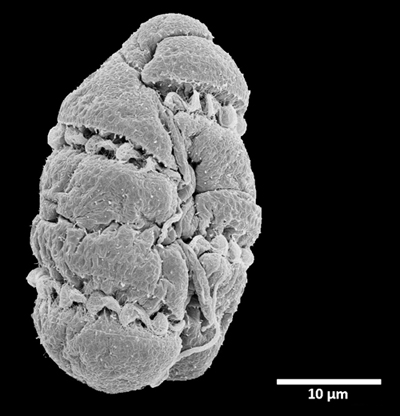Polykrikos tanit is part of the phytoplankton and belongs to the group of the dinoflagellates. This new species is photosynthetic, but also presents some appendices, called peduncles, which allow them to capture and ingest prey.
 Researchers from the Instituto de Ciencias del Mar (ICM) of the CSIC have detected and described a new species of microalgae, Polykrikos tanit, in the Catalan coast. The authors of the study, published in the Protist journal, are Albert Reñé, Jordi Camp and Esther Garcés, at the Instituto de Ciencias del Mar (ICM).
Researchers from the Instituto de Ciencias del Mar (ICM) of the CSIC have detected and described a new species of microalgae, Polykrikos tanit, in the Catalan coast. The authors of the study, published in the Protist journal, are Albert Reñé, Jordi Camp and Esther Garcés, at the Instituto de Ciencias del Mar (ICM).
This organism is part of the phytoplankton, microscopic photosynthetic organisms found at the base of the food chain, and belongs to the group of the dinoflagellates. Although P. tanit appears to be harmless, several species close to it are toxin-producers and cause serious economic impacts. Therefore, it is essential to identify and differentiate the harmful from the harmless species present at our shores.
This new species is photosynthetic, but also presents some appendices, called peduncles, which allow them to capture and ingest prey. This metabolic combination is known as mixotrophy. The researchers analyzed the genetic sequences of P. tanit, which placed it in an early evolutionary position within the genus Polykrikos. The name of the species comes from "Tanit", a Punic goddess worshiped in the western Mediterranean until the second century AD, and was chosen in reference to both the early evolutionary position of the species within the genus, and its type locality, the Catalan coast.
"The morphological features are not always easy to observe under the microscope and it is difficult to distinguish closely related species. Consequently, the classification of these organisms was dubious and often inconsistent. We are currently able to obtain their phylogenetic relationships, even from a single cell”, explains Albert Reñé, the scientist from the ICM-CSIC who led the study.
This discovery is framed on the PhD thesis of Albert Reñé, which examines the diversity of this group of organisms in depth. These studies also allowed characterizing an entire new family of dinoflagellates.
“All these results prove that many organisms that inhabit our planet are still unknown. Then, much more effort must be devoted to study this diversity and their phylogenetic relationships, without which is impossible to understand the evolution of life on Earth”, points out Albert Reñé.
Polykrikos tanit sp. nov., a New Mixotrophic Unarmoured Pseudocolonial Dinoflagellate from the NW Mediterranean Sea. Albert Reñé, Jordi Camp, Esther Garcés. Protist, Vol. 165 Issue 1, January 2014 http://dx.doi.org/10.1016/j.protis.2013.12.001
Página del grupo de investigación en el Instituto de Ciencias del Mar: http://pbl.cmima.csic.es/ca/content/inici
